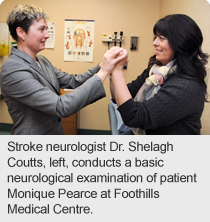
March 17, 2015
Story by Greg Harris; photo by Paul Rotzinger
Monique Pearce, 44, was sitting at her kitchen table having coffee last fall when she got the scare of her life.
The left side of her body began to feel weak, the side of her face felt like it was drooping, and a stab of pain shot through the left side of her neck.
“I thought I was having a stroke,” she says. “I freaked out. I phoned my husband and he came home from work, and then I called my sister, who’s a lifeguard.”
 Pearce rushed to the emergency department at Rockyview General Hospital, where she underwent a battery of tests that included blood work, an electrocardiogram, X-rays and a CT scan.
Pearce rushed to the emergency department at Rockyview General Hospital, where she underwent a battery of tests that included blood work, an electrocardiogram, X-rays and a CT scan.
She was later referred to Foothills Medical Centre where, after some additional testing, doctors presented their diagnosis: migraine.
“I was relieved that it wasn’t something worse but, at the same time, I thought, ‘I just went through all of these tests and used all these medical resources, and it’s only migraine?’ ”
Although doctors were able to rule out a stroke early on, they didn’t know for sure without extensive testing whether Pearce had had a transient ischemic attack (TIA), which is often likened to a ‘mini-stroke.’ TIAs go away on their own with little or no damage, but require medical attention as they carry a significant risk of having a major stroke.
Now, research at Foothills Medical Centre might one day significantly reduce the time and reliance on neuroimaging resources that are currently required to diagnose a TIA.
“Our goal is to identify and isolate specific proteins that are released into the bloodstream when someone’s experiencing a transient ischemic attack,” says Dr. Shelagh Coutts, a stroke neurologist with Alberta Health Services and principal investigator in the Calgary arm of the study, which is also underway in Victoria.
“This could eventually give us the same kind of blood test used to determine if people with heart attack symptoms have sustained damage to the heart. It would revolutionize the way we practise,” says Dr. Coutts, who is also an associate professor in the Department of Clinical Neurosciences and Radiology in the University of Calgary’s Cumming School of Medicine.
Strokes and TIAs are among the most common conditions seen in emergency departments. Every year, roughly 75,000 Canadians have a TIA, and another 75,000 experience an event that mimics a TIA.
TIAs can cause permanent brain damage and about a third of people who have a TIA go on to have a major stroke, which is a blockage in a blood vessel in the brain that results in damage to surrounding tissue. Strokes can be fatal or cause debilitating losses in motor function or cognitive function, depending on the extent and location of damage.
“It’s important to determine if a patient has had a transient ischemic attack. The challenge is that the same symptoms of a TIA can indicate other underlying issues, such as migraine, seizure, psychiatric conditions or carpal tunnel syndrome,” Dr. Coutts says.
Doctors can prescribe medications to people who have suffered a TIA to help prevent a stroke, or recommend lifestyle changes to reduce the risks. In some cases, surgery is necessary.
Symptoms of a stroke include difficulty speaking; sudden loss of strength or feeling in the face, an arm or leg; sudden vision problems; or a sudden or unusual headache. Anyone experiencing those symptoms should see a doctor – even if the symptoms go away.
In the study, patients who go to the emergency department at Foothills and present with the symptoms of a TIA are eligible to take part in the study. If they agree, a blood sample from them will be frozen and shipped to the Genome BC Proteomics Centre at the University of Victoria for analysis. They’ll also have some additional brain imaging, such as a CT scan or MRI.
Researchers in Calgary are looking for just over 2,000 study participants.